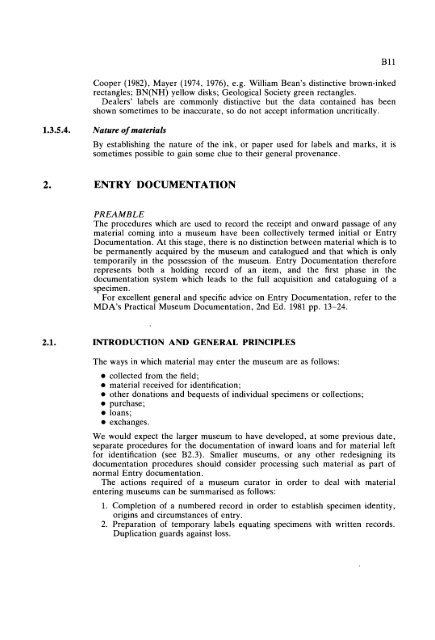GUIDELINES FOR THE CURATION OF GEOLOGICAL MATERIALS
GUIDELINES FOR THE CURATION OF GEOLOGICAL MATERIALS
GUIDELINES FOR THE CURATION OF GEOLOGICAL MATERIALS
Create successful ePaper yourself
Turn your PDF publications into a flip-book with our unique Google optimized e-Paper software.
Cooper (1982), Mayer (1974, 1976), e.g. William Bean's distinctive brown-inked<br />
rectangles; BN(NH) yellow disks; Geological Society green rectangles.<br />
Dealers' labels are commonly distinctive but the data contained has been<br />
shown sometimes to be inaccurate, so do not accept information uncritically.<br />
1.3.5.4. Nature of materials<br />
By establishing the nature of the ink, or paper used for labels and marks, it is<br />
sometimes possible to gain some clue to their general provenance.<br />
ENTRY DOCUMENTATION<br />
PREAMBLE<br />
The procedures which are used to record the receipt and onward passage of any<br />
material coming into a museum have been collectively termed initial or Entry<br />
Documentation. At this stage, there is no distinction between material which is to<br />
be permanently acquired by the museum and catalogued and that which is only<br />
temporarily in the possession of the museum. Entry Documentation therefore<br />
represents both a holding record of an item, and the first phase in the<br />
documentation system which leads to the full acquisition and cataloguing of a<br />
specimen.<br />
For excellent general and specific advice on Entry Documentation, refer to the<br />
MDA's Practical Museum Documentation, 2nd Ed. 1981 pp. 13-24.<br />
INTRODUCTION AND GENERAL PRINCIPLES<br />
The ways in which material may enter the museum are as follows:<br />
collected from the field;<br />
material received for identification;<br />
other donations and bequests of individual specimens or collections;<br />
purchase;<br />
loans;<br />
exchanges.<br />
We would expect the larger museum to have developed, at some previous date,<br />
separate procedures for the documentation of inward loans and for material left<br />
for identification (see B2.3). Smaller museums, or any other redesigning its<br />
documentation procedures should consider processing such material as part of<br />
normal Entry documentation.<br />
The actions required of a museum curator in order to deal with material<br />
entering museums can be summarised as follows:<br />
1. Completion of a numbered record in order to establish specimen identity,<br />
origins and circumstances of entry.<br />
2. Preparation of temporary labels equating specimens with written records.<br />
Duplication guards against loss.

















